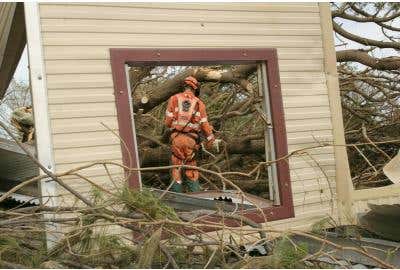10 Safety Tips for Disaster Recovery and Cleanup


This hurricane season has been exceptionally horrifying with several record-breaking events. There have been 13 named storms, 6 hurricanes and 3 major hurricanes (Category 3 or above). Hurricane Harvey’s long-lived odyssey had come to an end, leaving behind massive destruction that will take months, even years, to recover from. The latest, category 5 hurricane Maria is affecting the Caribbean islands, already heavily devastated by Hurricane Irma just a few weeks ago. Our thoughts are with those affected by such disasters.
Cleanup work of any kind is hazardous, but after the flood conditions make it even more so. Flooding can cause disruption of water purification and sewage disposal systems, overflowing of toxic wastes sites and dislodgement of chemicals previously stored above ground. Electrical and fire hazards connected with downed power lines also pose major threats. Floods can cause sickness in workers and others who came in contract with contaminated floodwater. Signs and symptoms of exposure to infectious organisms in floodwater include nausea, vomiting, diarrhea, abdominal cramps, muscle aches and fever. Pools of standing or stagnant water become breeding grounds for biological hazards such as mosquitoes, increasing risk of encephalitis, west Nile virus or other mosquito-borne diseases. And don’t forget about dangerous wildlife such as alligators and snakes that have been displaced by flood waters. Repeated or prolonged contact of the skin with flood water and continuous sweating can lead to fungal skin infections. Additionally, it’s important to be careful when driving during flood conditions. Nearly half of flood fatalities are vehicle related, according to OSHA.
Below are 10 safety tips for disaster cleanup and recovery. Though, keep in mind that some emergency response operations such as utility restoration, cleaning up spills or hazardous materials, and search and rescue must be conducted by qualified workers with proper training, equipment and experience.
-
1. Use wooden stick or pole to check flooded areas for pits, holes and protruding objects before entering. Conduct a preliminary worksite inspection to verify stability before entering building or operating vehicles over roadways or surfaces. Don’t work in or around any flood damaged building until it has been examined and certified as safe.
-
2. Use fuel powered generators outdoors. Do not bring them indoors!
-
3. Personal Protective Equipment: Use life vests for deep water exposure. Always wear water tight boots with steel toe and insole, gloves, long pants and safety glasses during cleanup operations. Sneakers should not be worn because they will not prevent punctures, bites or crash injuries.
-
4. Wear N-95 NIOSH approved dust respirator if working with moldy building materials or vegetable matter like hay stored grain or compost. Use respirator equipment in accordance with OSHA’s Respiratory Protection Standard 29 CFR 1910.134.
-
5. If damage to an electrical system is suspected, for example, the wiring has been under water and you can smell burning insolation, turn off the electrical system in the building and follow lockout / tagout procedures before starting work. Do not turn the power back on until equipment has been inspected by a qualified person.
-
6. To disinfect water, use 5 drops of liquid household bleach to each gallon of water and let sit for at least 30 minutes for disinfection to be completed.
-
7. Make sure your tetanus shot is current. Wounds associated with a flood should be evaluated for risk. Tetanus vaccination may be needed.
-
8. For workers exposed to mold or fungi, avoid breathing dust, fungal spores, generated by wet building materials, crops and other materials.
-
9. Surfaces that have a light covering of mold should be scrubbed with warm, soapy water and rinsed with a disinfectant made of 1/2 cup liquid household bleach mixed in one gallon of water. Do not mix bleach with other cleaning products that contain ammonia.
-
10. Large items with heavy mold growth should be covered with polyethylene sheeting and sealed with duct tape before being removed from the area.
You'll find all of these tips and more in our Safety and Health during Disaster Recovery course, which covers appropriate safety measures in response to floods, hurricanes, tornadoes, fires and other natural disasters.

